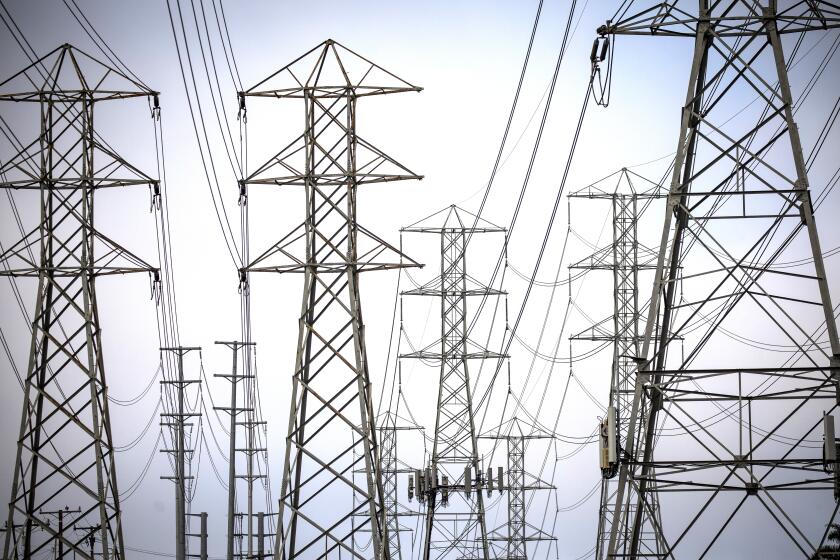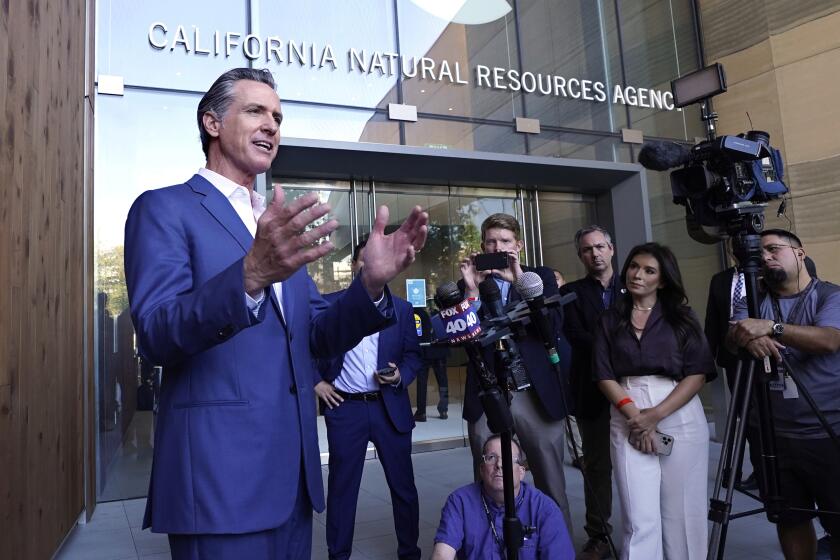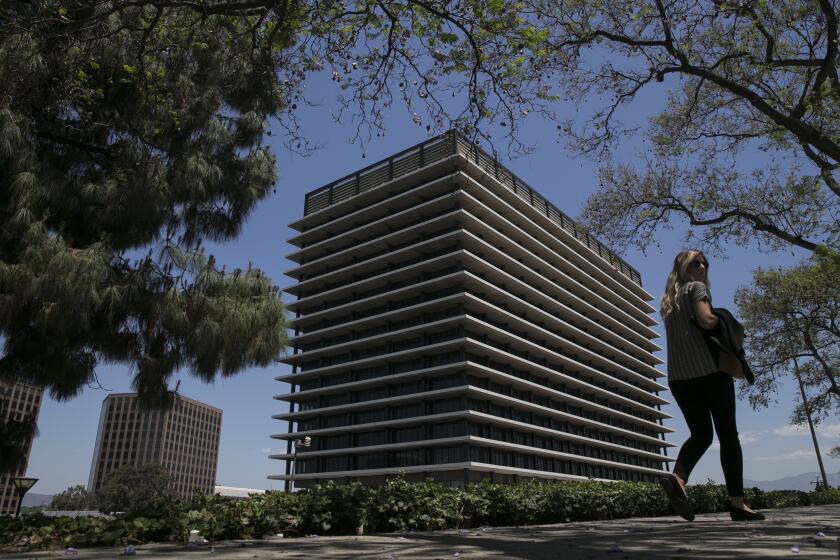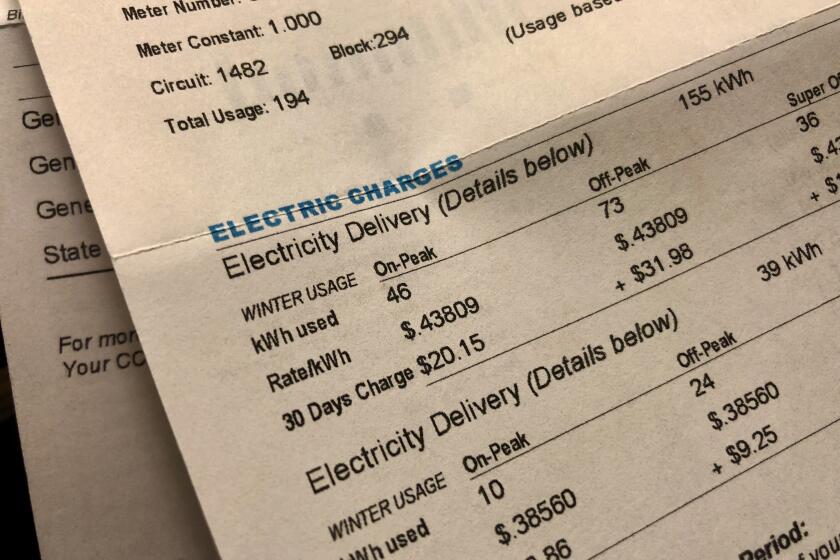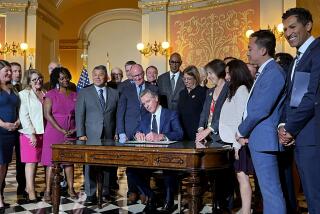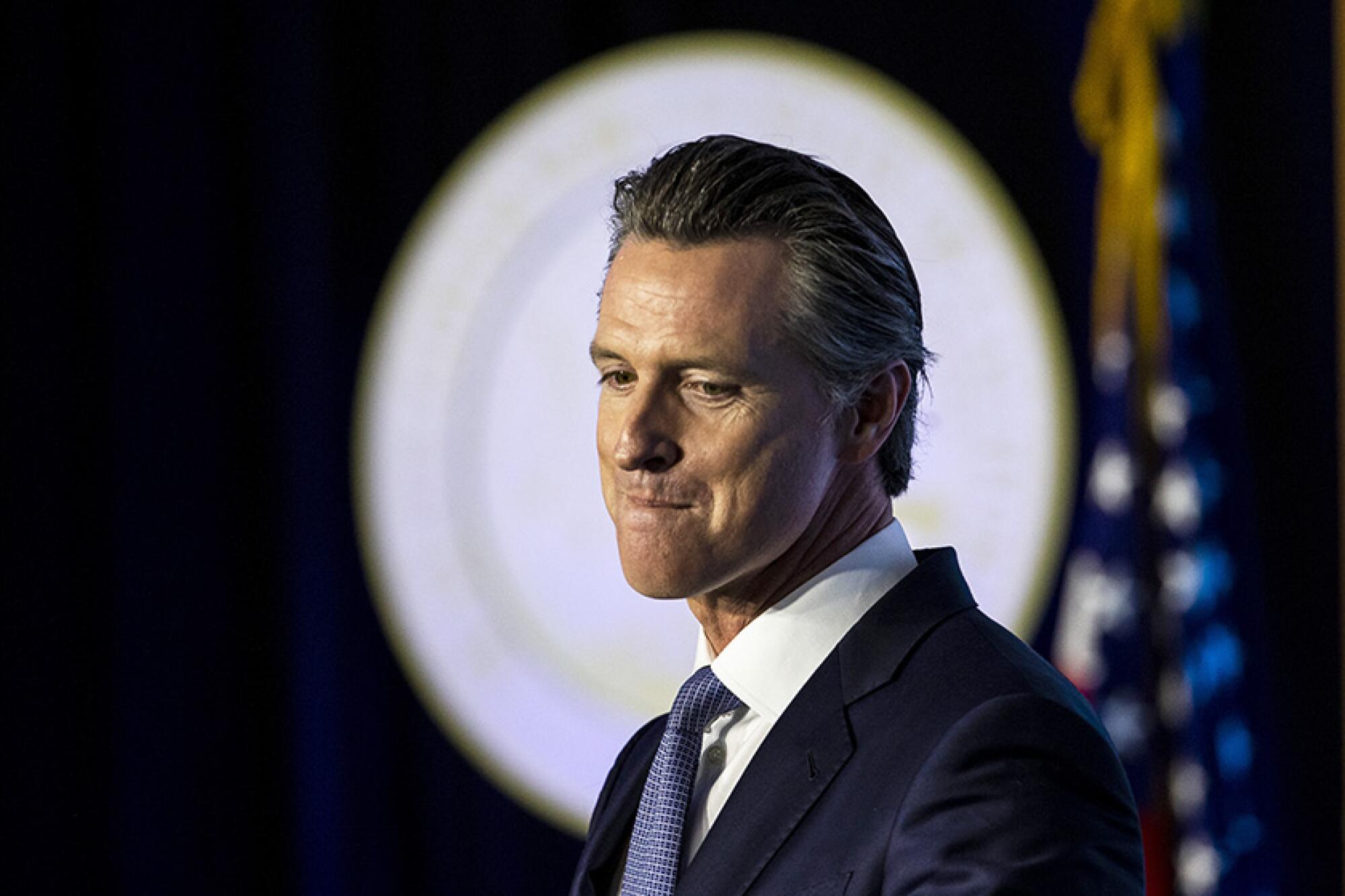
- Share via
Amid tense, closed-door negotiations, Gov. Gavin Newsom and Democratic lawmakers have released a suite of seven bills that aim to reduce Californians’ soaring energy costs — including a controversial electricity affordability plan that critics say was substantially weakened by lobbying from utilities and will offer little real relief.
The governor’s eleventh-hour energy and environment proposal also contains bills that would secure oil reserves and streamline the approval process for clean energy infrastructure projects, with Newsom threatening to force lawmakers to return to Sacramento this fall if an agreement can’t be reached on the oil item before the end of the legislative session.
The last minute tug-of-war between the governor and lawmakers left many stakeholders frustrated by the lack of time and transparency surrounding the bills, which must be approved by both houses of the state Legislature by the end of Saturday, when the two-year legislative session ends.
By offering the plan so late, it will most probably get little public debate.
Aggressive and impactful reporting on climate change, the environment, health and science.
The top item of concern among many environmental groups is Assembly Bill 3121. Critics say the bill seeks to reduce rising energy costs at the expense of several key energy and climate programs.
Analysts say the cuts will amount to a one-time savings of about $30 per consumer. Energy bills have been soaring in recent months due to increased demand driven by high temperatures, infrastructure upgrades and state regulations, among other factors.
But the plan seeks to achieve those savings by slashing three programs: The California Schools Healthy Air, Plumbing and Efficiency (CalSHAPE) Program, which funds HVAC improvements in schools; the Self-Generation Incentive Program (SGIP), which supports the installation of energy storage and generation technologies in vulnerable communities; and the Solar on Multifamily Affordable Housing (SOMAH) program, which helps fund solar energy systems on multifamily affordable housing.
The programs “provide a myriad of climate, health, and affordability benefits to schools, tenants, and low-income communities in addition to the general ratepayer,” wrote a coalition of environmental, education, housing and energy groups in an Aug. 19 open letter opposing the package.
“Cutting them would provide negligible reductions on energy bills in the short-term, while sacrificing the long-term climate and affordability benefits they provide.”
Some Southern California consumers say they’re frustrated with their costly electricity bills. Here’s what to do about it.
Over the last 10 years, rates at California’s three big utility companies have risen by as much as 110%, according to a recent quarterly report by the California Public Utilities Commission’s Public Advocates Office.
In just the past three years, bills for customers of the three biggest for-profit utilities — Pacific Gas & Electric, Southern California Edison and San Diego Gas & Electric — have increased by 20% to 50%.
Critics said the plan fails to address the root causes of escalating bills, which include an electric rate setting system that allows the utility companies to earn profits as they build new transmission lines and other infrastructure and then bill customers for the expense.
“Distributed energy resource programs like SGIP and SOMAH have the potential to deliver substantial long-term benefits in terms of affordability, resilience, and reliability for all ratepayers,” read a statement from Edson Perez, California policy lead at Advanced Energy United. “California should focus on leveraging investments that both support disadvantaged communities and ratepayers, rather than reversing support of these crucial programs.”
Stephanie Seidmon, program director at Undaunted K12 — a nonprofit that advocates for climate resilience in schools — said the HVAC program is particularly important at a moment when COVID-19 is surging and California is dealing with worsening heat waves and wildfires, all of which underscore the need for proper air conditioning and ventilation in schools.
“These school districts are now left in the lurch because the program is effectively suspended,” Seidmon said. “This is just a really short-sighted giveaway that’s not making meaningful impact on the affordability crisis.”
California Gov. Gavin Newsom’s ultimatum is intended to counter the pressure oil interests are putting on lawmakers to reject his proposal that could require petroleum refiners to maintain a stable inventory.
Also stirring controversy is Senate Bill 950, which is aimed at controlling high prices at the gas pump by requiring petroleum refiners to maintain a stable inventory in order to prevent fuel shortages and price spikes when equipment is taken offline for maintenance.
Sources involved in the negotiations told The Times that some Assembly Democrats are concerned that adopting new requirements on oil refiners could ultimately increase the cost of gasoline. Lawmakers are also reportedly facing pressure from oil interests to reject the proposal.
In response, Newsom has proposed a special session that would bring lawmakers back to Sacramento in the fall, allowing for more time to weigh the proposal.
But Senate President Pro Tem Mike McGuire (D-Healdsburg) said Thursday he opposes convening a special session, and indicated that he wants the Senate to approve the measures before the end of the weekend.
“Californians shouldn’t have to wait for relief at the pump and on their utility bills,” McGuire said. “Inflation has been impacting the lives of millions and waiting for a special session will only make the problem worse for working families.”
“We’ve been working nonstop to deliver results and get these measures across the finish line. We’re ready — right now — to get the bills passed, sent to the governor, and signed into law,” he said.
DWP ratepayer advocate predicts fee increases, recommends delaying city’s 100% clean energy timeline
The Office of Ratepayer Advocacy report said the expected costs are “not reasonable” for customers.
Other bills included in the package received a warmer reception from some environmental advocates, however.
Among them is Assembly Bill 3264, which would require the Public Utilities Commission to develop a framework for assessing and analyzing total annual energy costs for residential households.
The item calls for greater transparency from the PUC, including better reporting around what is driving costs, and a review of demand-side management programs that affect customer usage.
“Several of [these bills] are really positive steps in the right direction and will provide more oversight, more information, to start to correct some of the issues that we’re seeing with affordability in California,” said Merrian Borgeson, a policy director with the Natural Resources Defense Council. “AB 3264, I think, has some really positive things in it.”
Also better received were Senate Bill 1003, which calls for increased oversight over wildfire mitigation spending, including line hardening and vegetation management projects that can drive up costs, and Senate Bill 1142, which would require electric and gas utilities to reconnect service for residential customers who had it cut off because of nonpayment when customers agree to a payment plan.
The bills “at least try to address some of the problems that we’re seeing” with energy affordability, Borgeson said. However, she too was concerned by AB 3121, the bill that would cut solar and HVAC programs to provide one-time savings.
“Unfortunately, that relief is tiny, and it’s at the expense of programs that are providing updated ventilation to schools, solar on affordable housing — things that are really important for both climate and equity goals in the state,” she said.
Electric bills are rising. Here are ways to reduce the burden without slowing the shift to home and vehicle electrification to meet our climate goals.
The remaining items in the energy package, Senate Bill 1272 and Senate Bill 1420, both involve the California Environmental Quality Act, or CEQA, and are aimed at accelerating clean energy development in the state through limiting environmental review processes and expedited permitting.
SB 1272 would “accelerate clean energy development,” according to Newsom’s staff, by speeding up the review process for potential harms the projects might have on the environment. The bill by state Sen. John Laird (D-Santa Cruz) says, “it is in the interest of the state to ensure that California’s environmental review processes are streamlined and optimized to ensure the most efficient process.”
The Legislature previously approved bills that are now state law that say 60% of California electricity must come from renewable sources by 2030 and 100% by 2045.
SB 1420 would similarly fast-track the development of federally funded clean, renewable hydrogen production facilities by authorizing them as eligible for the California Energy Commission’s expedited review permitting process and expedited CEQA judicial review process.
Last year, President Biden named California one of seven hydrogen hubs in the nation — a designation that included a $1.2-billion federal investment toward building infrastructure for a “clean” hydrogen economy to replace fossil fuels and reduce greenhouse gas emissions in the state. However, some environmentalists remain wary of hydrogen’s promise.
Despite the tension surrounding Newsom’s last-minute maneuvering, most experts concurred that high energy costs in California should be addressed.
Mark Toney, executive director of The Utility Reform Network (TURN) — a consumer advocacy group — said the governor’s original electricity affordability plan included a measure that would have lowered the interest rates that utilities earn on capital investments such as transmission lines and power plants.
Current policy encourages utilities to build expensive infrastructure because they get to recover the cost — plus annual interest that is typically 10.5% — through rates billed to customers. The original plan was aimed at reducing that rate through a financing technique called securitization.
“It would create significant savings,” Toney said of the original proposal.
However, the Sacramento Bee reported last week that Newsom had backed away from the proposal after criticism from big utilities.
At the same time, the state is pushing consumers to use more electricity by purchasing electric cars and replacing their gas appliances.
In May, the Newsom administration ignored complaints by hundreds of electric customers and pushed through a plan to add a new mandatory fixed charge of $24.15 to each monthly electric bill. In return, customers will pay a lower rate for each kilowatt hour of power they use.
The three big utilities had lobbied for the new fixed charge. That bill was also unveiled so late by Newsom that it was impossible for it to be fully debated in hearings.
Times staff writer Taryn Luna contributed to this report.

